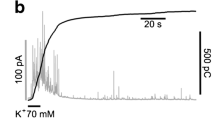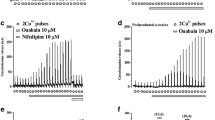Summary
The bag cell neurons of Aplysia provide a model system in which to investigate the effects of hyperosmolality on the electrical and secretory properties of neurons. Brief stimulation of these neurons triggers an afterdischarge of action potentials that lasts approximately 20–30 min, during which time they release several neuroactive peptides. We have found that pre-incubation of intact clusters of bag cell neurons in hyperosmotic media prior to stimulation prevents the initiation of afterdischarges. Furthermore, an increase in osmolality of the external medium during an ongoing afterdischarge causes its premature termination. Hyperosmotic media attenuate the release of peptide evoked by both electrically stimulated afterdischarges and potassium-induced depolarization. The ability of high potassium to depolarize the bag cell neurons is, however, not impaired. Exposure of isolated bag cell neurons to hyperosmotic media also inhibits the amplitude of action potentials evoked by depolarizing current injection and attenuates the voltage-dependent calcium current. In isolated bag cell neurons loaded with the calcium indicator dye, fura-2, hyperosmotic media reduced the rise in intracellular calcium levels that normally occurs in response to depolarization. Our results suggest that the effects of hyperosmotic media on peptide secretion in bag cell neurons can largely be attributed to their effects on calcium entry.
Similar content being viewed by others
References
Arch, S. 1972. Biosynthesis of egg-laying hormone (ELH) in the bag cell neurons of Aplysia californica. J. Neurophysiol. 43:399–519
Arieff, A.I., Caroll, H.J. 1972. Nonketotic hyperosmolar coma with hyperglycemia: Clinical features, pathophysiology, renal function; acid-base balance, plasma-cerebrospinal fluid equilibrium and effects of therapy in 37 cases. Medicine 51:73–94
Arieff, A.I., Caroll, H.J. 1974. Cerebral edema and depression of sensorium in nonketotic hyperosmolar coma. Diabetes 23:525–531
Berry, R.W. 1988. Alpha bag cell peptide reduces stimulated cAMP levels and pro-ELH synthesis in bag cells. Mol. Brain Res. 4:267–271
Blankenship, J.E., Haskins, J.T. 1979. Electrotonic coupling among neuroendocrine cells in Aplysia. J. Neurophysiol. 42:347–355
Brown, E.M., Pazoles, C.J., Creutz, C.E., Aurbach, G.D., Pollard, H.B. 1978. Role of anions in parathyroid hormone release from dispersed bovine parathyroid cells. Proc. Natl. Acad. Sci. USA 75:876–880
Brown, R.O., Mayeri, E. 1989. Positive feedback by autoexcitatory neuropeptides in neuroendocrine bag cells of Aplysia. J. Neurosci. 9:1443–1451
Chandler, D.E., Whitaker, M., Zimmerberg, J. 1989. High molecular weight polymers block cortical granule exocytosis in sea urchin eggs at the level of granule matrix disassembly. J. Cell Biol. 109:1269–1278
Chiu, A.Y., Hunkapiller, M.W., Heller, E., Stuart, D.K., Hood, L.E., Strumwasser, F. 1979. Purification and primary structure of neuroactive egg-laying hormone of Aplysia californica. Proc. Natl. Acad. Sci. USA 76:6656–6660
Connor, J.A. 1986. Digital imaging of free calcium changes and of spatial gradients in growing processes in single, mammalian central nervous system cells. Proc. Natl. Acad. Sci. USA 83:6179–6183
Fink, L.A., Connor, J.A., Kaczmarek, L.K. 1988. Inositol triphosphate releases intracellularly stored calcium and modulates ion channels in molluscan neurons. J. Neurosci. 8:2544–2555
Frazier, W.T., Kandel, E.R., Kupfermann, I., Waziri, R., Coggeshall, R.E. 1967. Morphological and functional properties of identified neurons in the abdominal ganglion of Aplysia californica. J. Neurophysiol. 30:1288–1351
Grinstein, S., Cohen, S., Goetz, J.D., Rothstein, A. 1985. Osmotic and phorbol ester-induced activation of Na+/H+ exchange: Possible role of protein phosphorylation in lymphocyte volume regulation. J. Cell Biol. 101:269–276
Grynkiewicz, G., Poenie, M., Tsien, R.Y. 1985. A new generation of Ca2+ indicators with greatly improved fluorescence properties. J. Biol. Chem. 260:3440–3450
Hampton, R.Y., Holz, R.W. 1983. Effects of changes in osmolality on the stability and function of cultured chromaffin cells and the possible role of osmotic forces in exocytosis. J. Cell Biol. 96:1082–1088
Heldman, E., Levine, M., Morita, K., Pollard, H.B. 1991. Osmotic strength differentiates between two types of calcium transport pathways regulating catecholamine secretion from cultured bovine chromaffin cells. Biochim. Biophys. Acta 1091:417–425
Holz, R.W., Senter, R.A. 1986. The effects of osmolality and ionic strength on secretion from adrenal chromaffin cells permeabilized with digitonin. J. Neurochem. 46:1835–1842
Kaczmarek, L.K., Finbow, M., Revel, J.-P., Strumwasser, F. 1979. The morphology and coupling of Aplysia bag cells within the abdominal ganglion and in cell culture. J. Neurobiol. 10:535–550
Kaczmarek, L.K., Jennings, K.R., Strumwaser, F. 1982. An early sodium phase and a late calcium phase in the afterdischarge of peptide-secreting neurons of Aplysia. Brain Res. 238:105–115
Kaczmarek, L.K., Strumwasser, F. 1981. The expression of longlasting afterdischarge by isolated Aplysia bag cell neurons. J. Neurosci. 1:626–634
Kaczmarek, L.K., Strumwasser, F. 1984. A voltage-clamp analysis of currents underlying cyclic AMP-induced membrane modulation in isolated peptidergic neurons of Aplysia. J. Neurophysiol. 52:340–349
Kater, S.B., Mattson, M.P., Cohan, C., Connor, J.A. 1988. Calcium regulation of the neuronal growth cone. Trends Neurosci. 11:315–321
Kauer, J.A., Fisher, T.E., Kaczmarek, L.K. 1987. Alpha bag cell peptide directly modulates the excitability of the neurons that release it. J. Neurosci. 7:3623–3632
Kazilek, C.J., Merkle, C.J., Chandler, D.E. 1988. Hyperosmotic inhibition of calcium signals and exocytosis in rabbit neutrophils. Am. J. Physiol. 254:C704-C718
Knight, D.E., Baker, P.F. 1982. Calcium-dependence of catecholamine release from bovine adrenal medullary cells after exposure to intense electric fields. J. Membrane Biol. 68:107–140
Knox, R.J., Quattrocki, E.A., Connor, J.A., Kaczmarek, L.K. 1992. Recruitment of calcium channels during rapid formation of putative release sites in isolated Aplysia neurons. Neuron (in press)
Ladona, M.G., Bader, M.F., Aunis, D. 1987. Influence of hypertonic solutions on catecholamine release from intact and permeabilized cultured chromaffin cells. Biochim. Biophys. Acta 927:18–25
Loechner, K.J., Azhderian, E.M., Dreyer, R., Kaczmarek, L.K. 1990. Progressive potentiation of peptide release during a neuronal discharge. J. Neurophysiol. 63:738–744
Loechner, K.J., Kaczmarek, L.K. 1989. Hypertonic solutions block peptide secretion and afterdischarges in Aplysia bag cell neurons. Soc. Neurosci. Abstr. 15:1275
Loechner, K.J., Kaczmarek, L.K. 1990. Control of potassium currents and cyclic AMP levels by autoactive neuropeptides in Aplysia neurons. Brain Res. 532:1–6
Loechner, K.J., Knox, R.J., Connor, J.A., Kaczmarek, L.K. 1991. Modification of calcium current by hyperosmotic media in control and phorbol ester treated neurons. Soc. Neurosci. Abstr. 17:774
Mayeri, E., Rothman, B.S., Brownell, P.H., Branton, W.D., Padgett, L. 1985. Nonsynaptic characteristics of neurotransmission mediated by egg-laying hormone in the abdominal ganglion of Aplysia. J. Neurosci. 5:2060–2072
Merkle, C.J., Chandler, D.E. 1989. Hyperosmolality inhibits exocytosis in sea urchin eggs by formation of a granule-free zone and arrest of pore widening. J. Membrane Biol. 112:223–232
Newcomb, R., Scheller, R.H. 1987. Proteolytic processing of Aplysia egg-laying hormone and R3-R14 neuropeptide precursors. J. Neurosci. 7:853–863
O'Sullivan, A.J., Burgoyne, R.D. 1988. The role of cytoplasmic pH in the inhibitory action of high osmolarity on secretion from bovine adrenal chromaffin cells. Biochim. Biophys. Acta 969:211–216
Roth, M. 1971. Fluorescence reaction for amino acids. Anal. Chem. 43, 880–882
Rothman, B.S., Mayeri, E., Brown, R.D., Yuan, P., Shively, J. 1983. Primary structure and neuronal effects of alpha bag cell peptide, a second candidate neurotransmitter encoded by a single gene in bag cell neurons of Aplysia. Proc. Natl. Acad. Sci. USA 80:5733–5757
Rothman, B.S., Sigvardt, K.A., Mayeri, E. 1985. Co-release of five peptides, ELH, AP, alpha-, beta-, and gamma-BCP, derived from a common precursor protein of the bag cells of Aplysia. Soc. Neurosci. Abstr. 11:482
Sato, N., Wang, X., Greer, M. 1991. Medium hyperosmolarity depresses thyrotropin-releasing hormone-induced Ca2+ influx and prolactin secretion in GH4C1 cells. Mol. Cell. Endocrinol. 77:193–198
Scheller, R.H., Jackson, J.F., McAllister, L.B., Rothman, B.S., Mayeri, E., Axel, R. 1983. A single gene encodes multiple neuropeptides mediating a sterotyped behavior. Cell 32:7–22
Scheller, R.H., Jackson, J.F., McAllister, L.B., Schwartz, J.H., Kandel, E.R., Axel, R. 1982. A family of genes that codes for ELH, a neuropeptide eliciting a stereotyped pattern of behavior in Aplysia. Cell. 28:707–719
Sigvardt, K.A., Rothman, B.S., Brown, R.O., Mayeri, E. 1986. The bag cells of Aplysia as a multitransmitter system; identification of alpha bag cell peptide as a second transmitter. J. Neurosci. 6:803–813
Strong, J.A., Fox, A.P., Tsien, R.W., Kaczmarek, L.K. 1987. Stimulation of protein kinase C recruits covert calcium channels in Aplysia bag cell neurons. Nature 325:714–717
Whitaker, M., Zimmerberg, J. 1987. Inhibition of secretory granule discharge during exocytosis in sea urchin eggs by polymer solutions. J. Physiol. 389:527–539
Zimmerberg, J., Bezanilla, F., Parsegian, V.A. 1990. Solute inaccessible aqueous volume changes during opening of the potassium channel of the squid giant axon. Biophys. J. 57:1049–1064
Zimmerberg, J., Parsegian, V.A. 1986. Polymer inaccessible volume changes during opening and closing of a voltage-dependent ionic channel. Nature 323:36–39
Author information
Authors and Affiliations
Additional information
This work was supported by NIH Grant NS-18492 to L.K. Kaczmarek.
Rights and permissions
About this article
Cite this article
Loechner, K.J., Knox, R.J., Connor, J.A. et al. Hyperosmotic media inhibit voltage-dependent calcium influx and peptide release in Aplysia neurons. J. Membarin Biol. 128, 41–52 (1992). https://doi.org/10.1007/BF00231869
Received:
Revised:
Issue Date:
DOI: https://doi.org/10.1007/BF00231869




